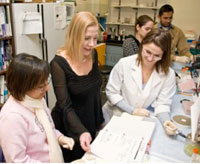| |
You’ve probably heard about or experienced puberty — the hormonal changes, mood swings, and anxiety that accompany human sexual maturation. There are other more subtle changes during puberty that you may be less familiar with, though. For example, you might find it more difficult to learn a second language, navigate a new city, or get good at a musical instrument. This type of learning, called spatial learning, may decrease during puberty. Often these changes occur more in girls than boys. These learning difficulties are only temporary, and after puberty girls will recover any such abilities they had lost.
New research has revealed that such changes in learning during puberty can be attributed to a specific chemical receptor in the brain known as the alpha-4-beta-delta gamma-aminobutyric acid receptor (GABAR) or the α4βδ GABAR for short. Don’t worry, there is no quiz at the end.
Dr. Sheryl Smith, a neuroscientist at the State University of New York Downstate Medical Center, led the team of researchers who made this discovery. She has spent her career studying the family of neuroreceptors called GABARs and their role during puberty. Neuroreceptors allow for the transfer of information between neurons in the brain. Dr. Smith first chose to study GABARs because little was known about their function. There are many types of GABARs in the brain and the α4βδ GABAR is one of these receptors. All GABARs are known as inhibitory receptors because, when stimulated, they stop the neuron from functioning. [See, for example, the What A Year! stories for February 2007, and November 2008.]
Normally there are small numbers of GABARs in all parts of the brain. But the α4βδ GABARs were shown to increase in response to the hormonal changes that accompany puberty. Dr. Smith wanted to know if there was a change in the number of α4βδ GABARs during puberty. She hypothesized that these receptors might play a role in learning changes in pubescent girls.
To do this, she used an analytical technique known as western blots to determine the amount of GABARs in the brains of female mice before, during, and after puberty. A western blot is an apparatus that separates proteins using electric charge. Since the sizes of different GABARs are known, the concentrations of the proteins are seen as dark lines on the western blot. The bolder the line, the more protein is in the sample. A sample apparatus and analyzed blot are shown below:
For additional accuracy, Dr. Smith used another analytical technique known as immunocytochemistry. This technique uses the principle of antigen-antibody binding to directly label these receptors in the hippocampus. Dr. Smith injected antibodies that bind to specific parts of the α4βδ GABAR to ensure that these were the receptors identified by the western blots.
The Discovery
Dr. Smith found that during puberty there was more than a seven-fold increase in the amount of α4βδ GABARs in the part of the brain called the hippocampus. Since the hippocampus is known to be responsible for learning and memory, Dr. Smith hypothesized that the increase in α4βδ GABARs during puberty might be related to changes in learning experienced by pubescent girls.
To test her hypothesis, Dr. Smith conducted a series of behavioral tests on female rats to measure their spatial learning ability before, during, and after puberty. These tests involved using an apparatus which consists of a rotating round platform that gives a brief electric shock. The rats are placed into this apparatus and must learn to avoid the shock. Before puberty, it takes a normal rat three tries to learn to avoid the shock. During puberty, however, these same animals have trouble avoiding the shock and do not learn to avoid it in the three trials it took them as pre-pubescents. Based on these data, Dr. Smith hypothesized that the spatial learning ability of rats was impaired during puberty.
To further confirm that these changes in learning ability were due to an increased number of α4βδ GABARs, Dr. Smith used a special kind of mice called transgenic mice that lacked the α4βδ GABAR gene. These mice were placed in the same apparatus described above and their spatial learning ability was measured before, during and after puberty. Dr. Smith found the transgenic mice did not exhibit changes in spatial learning ability during puberty because they lacked the α4βδ GABAR gene. Based on these results, Dr. Smith concluded that increased α4βδ GABAR activity may be responsible for the changes in learning experienced by some girls during puberty.
In future research, Dr. Smith would like to figure out more details about this increase in α4βδ GABARs during puberty. She would also like to extend these experiments throughout the lifespan of the animals to see if there are similar changes at menopause, and to repeat these experiments on male mice to see if there are any sex differences.
Dr. Sheryl Smith is a Professor of Physiology and Pharmacology at the State University of New York Downstate Medical Center. She studies the GABA receptor and its affects on mood and learning in adolescents. When not in the lab, Dr. Smtih enjoys the outdoors and spending time with her two teenage children.
Dr. Smith’s Research As Reported in the News:
- Does Puberty Make You Stupid? — Time Magazine/CNN
http://www.time.com/time/health/article/0,8599,1973532,00.html
- Testing Improves Memory. (podcast) — AAAS/Science Magazine
http://www.sciencemag.org/cgi/content/full/sci;327/5972/1515/DC2
- This Is Your Brain on Puberty — Discover
http://blogs.discovermagazine.com/80beats/2010/03/22/this-is-your-brain-on-puberty-study-probes-why-learning-slows-for-teens/
- Learning May Be Tougher for the Teen Brain — MSN Health and Fitness
http://health.msn.com/health-topics/articlepage.aspx?cp-documentid=100255985
- Why Do We Lose Learning Ability? ABC News/Health
http://abcnews.go.com/Health/MindMoodNews/study-hints-lose-learning-ability/story?id=10164300
For More Information:
- Shen, H., et al. 2010. “A Critical Role for α4βδ GABAA Receptors in Shaping Learning Deficits at Puberty in Mice. Science, 327: 1515-1518.
- Smith, S. C. Aoki, and H. Shen. 2009. “Puberty, steroids and GABAA receptor plasticity.” Pyschoneuroendocrinology, 345: S91-S103.
- Shen, H., et al. 2007. “Reversal of neurosteroid effects at α4βδ GABAA receptors triggers anxiety at puberty. Neuroscience, 10(4): 397-399.
To Learn More:
Written by Rebecca Kranz with Andrea
Gwosdow, Ph.D. Gwosdow
Associates
HOME | ABOUT | ARCHIVES | TEACHERS | LINKS | CONTACT
All content on this site is © Massachusetts
Society for Medical Research or others. Please read our copyright
statement — it is important. |
|
| 
Dr. Sheryl Smith

Dr. Smith's Laboratory
front row, Shweta Varshney, Dr. Smith, Nicole Sabaliauskas; rear, Nicole Lapadura, Ahmer Ishtiaq
Sign Up for our Monthly Announcement!
...or  subscribe to all of our stories! subscribe to all of our stories!

What A Year! is a project of the Massachusetts
Society for Medical Research.
|
|

